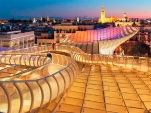Metropol Parasol – The Cathedral without Walls

Metropol Parasol, the Redevelopment of the Plaza de la Encarnacíon in Seville, designed by J. MAYER H. architects, becomes the new icon for Seville, capital of Andalusia - a place of identification and to articulate Seville’s role as one of the world´s most fascinating cultural destinations. Now this amazing building in many respects defines appearance of the ancient city and emphasizes its uniqueness as one of the most fascinating in the world. “Who has not seen Seville, he did not see the miracle” - says the Spanish proverb. The Metropol Parasol building – is one more proof of this wise saw.
“Metropol Parasol” explores the potential of the Plaza de la Encarnacion to become the new contemporary urban centre. Its role as a unique urban space within the dense fabric of the medieval inner city of Seville allows for a great variety of activities such as memory, leisure and commerce. A highly developed infrastructure helps to activate the square, making it an attractive destination for tourists and locals alike.
The “Metropol Parasol“ scheme with its impressive timber structures offers an archaeological museum, a farmers market, an elevated plaza, multiple bars and restaurants underneath and inside the parasols, as well as a panorama terrace on the very top of the parasols. Realized as one of the largest and most innovative bonded timber-constructions with a polyurethane coating, the parasols grow out of the archaeological excavation site into a contemporary landmark, defining a unique relationship between the historical and the contemporary city. “Metropol Parasol’s” mixed-use character initiates a dynamic development for culture and commerce in the heart of Seville and beyond.
Thus the construction is not separated from the other buildings, and is an integral part of the existing development. It can be observed both - from the surrounding streets and from the inside, and the unusual design only enhances the experience.
The exceedingly developed infrastructure aids in triggering the movement at the square, thus transforming it into a hive of activity – a social and cultural hub where both residents, visitors and tourists can gather under the architecturally motivating ‘crown-like waffle’.
Full content of this issue you can read here
The full version of the article can be read in our printed issue, also you can subscribe to the web-version of the magazine
 Material sprovided by J. MAYER H. Architects
Material sprovided by J. MAYER H. Architects


